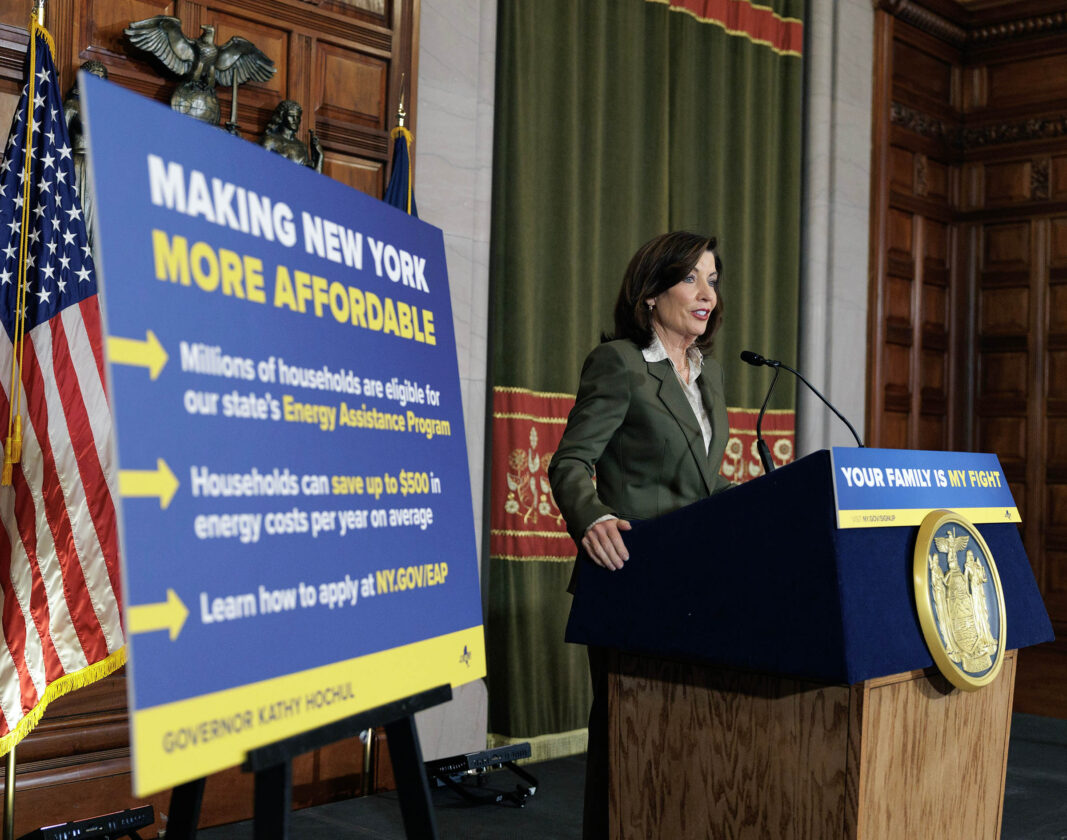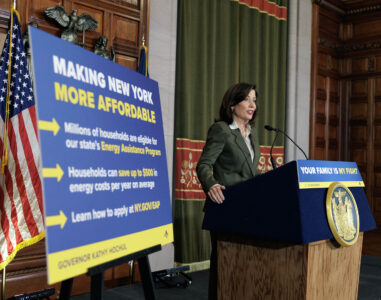HEAP deadline delayed again
Hochul calls on Trump administration to restore funds; Funding will not reach New Yorkers until at least Nov. 24

From the state Capitol in Albany on Monday, Gov. Kathy Hochul calls on the Trump administration to release federal heat assistance funding. (Photo courtesy of the Gov. Kathy Hochul’s office —Mike Groll)
ALBANY — New Yorkers looking to get help with their heating bills through the HEAP program are still waiting for the program to open — and the deadline has been pushed again.
The federal Low Income Heating and Energy Assistance Program, LIHEAP, hasn’t been restarted as the federal government lurches back to full operations after a historic 44-day shutdown. The unprecedented lapse in government operations means that money that’s put aside almost automatically for benefit programs including LIHEAP and the Supplemental Nutrition Assistance Program, wasn’t made available.
Now, LIHEAP money is still not being sent to the states, as the Department of Health and Human Services slowly restores funding and returns staff to process grant payments. Adding onto the delay, the Trump administration earlier this year fired the entire LIHEAP team at HHS. It’s unclear how the program is organized now.
States that rely on LIHEAP funding, primarily in the north of the U.S., told potential applicants that the application period would open late this year. New York told residents its HEAP program would open on Monday, two weeks after the anticipated Nov. 3 opening date.
But on Monday, Gov. Kathy C. Hochul said from the Capitol in Albany that the program would be delayed again, to Nov. 24, with the caveat that the federal government still needs to provide the money by that date.
New York expects $400 million from the LIHEAP program, to help cover energy and heating costs for 1.5 million low-income New Yorkers. It’s targeted to the colder weather months, although a version exists to cover cooling costs as well in the summer. HEAP can offer one payment, sometimes for over $1,000 to assist with costs for heating in the winter. Benefit totals vary widely based on fuel type, household size and income level, but can provide more than $1,000 in some instances.
“If you’re a family of four and make up to $80,000 or a family of five that makes $90,000, they can enroll in these discounts,” Hochul said.
More details on HEAP eligibility can be found at wdt.me/HEAP.
Now, as temperatures drop, Hochul said she is worried about the impact this delay is having on New Yorkers.
“New Yorkers woke up to below freezing temperatures,” she said. “A little early in my opinion, but I looked at the thermometers, the temperature all over the state — north country, over to Buffalo, down to Long Island, the city, here in the capital region. It is a cold day out there, and that is a cold reminder of what we’re facing.”
Hochul said the pain is multiplied by the fact that many people who rely on HEAP to help cover their higher energy bills in the heating season also rely on other benefits, like SNAP or Medicaid, which have both seen both temporary interruption and long-term cuts. SNAP, like LIHEAP, was not funded as usual during the government shutdown, and benefits only started going out in piecemeal last week, a week later than they were due. Some states were still rolling out food stamp benefits as of Monday.
“We have 1.5 million New York households that are going to be facing the possibility of entering this winter without the support they’ve been able to count on, and they, therefore, will not be able to afford their energy bills,” Hochul said. “Two-thirds of them include small children, older adults or people with disabilities — again, the most vulnerable among us.”
Hochul said she still wants people to sign up for the program, and said her administration would continue to commit to other state-level programs aimed at keeping people warm in the winter. That includes enforcing state laws that bar utility companies from shutting off power to households unlikely to be able to restore power quickly in the winter months.
There’s also the state-run Energy Affordability Program, EAP, which applies to people living at or below the federal poverty line. Enrolling in the EAP provides monthly discounts on eligible electric or gas utility bills, aiming to make annual energy costs equal to 6% of a household’s income.
This is achieved through a combination of “budget billing” programs that equalize energy costs across the year, and a standardized discount program meant to keep up with costs and inflation. EAP discounts automatically apply to HEAP recipients, as well as anyone on SNAP, Medicaid, veteran disability or survivor pension, Supplemental Security Income, federal public housing assistance, TANF recipients and a handful of tribal programs for Native Americans in New York.
Next year, the EAP program will be available for all utility customers who make less than the statewide median income, $39,874 for an individual and $76,681 for a family of four in 2025.



